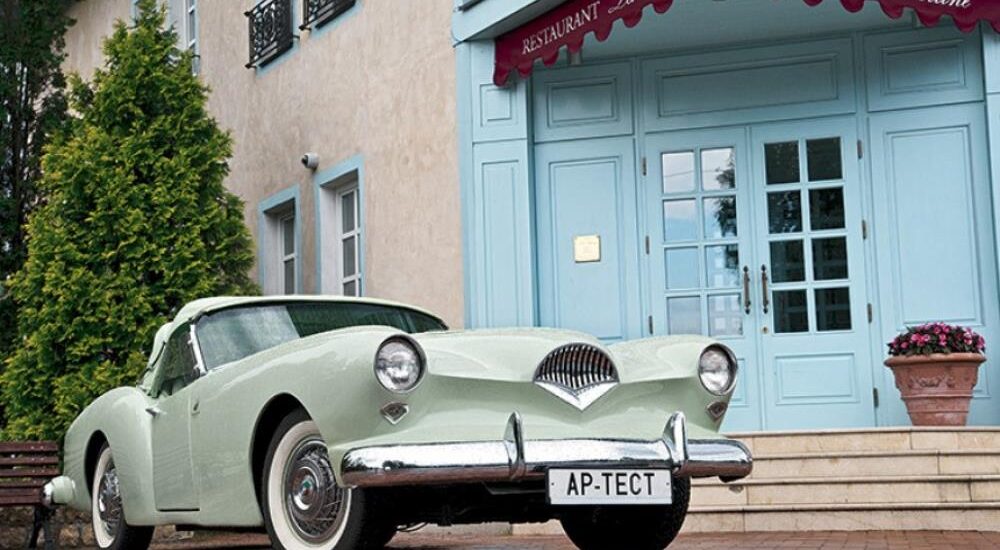History often unfolds in surprising ways, and the American automotive landscape is no exception. While the Chevrolet Corvette reigns supreme as an American icon today, it’s worth noting that the Kaiser Darrin could have easily stolen the spotlight. In a parallel universe where the GM conglomerate faced a bit less fortune and entrepreneur Henry Kaiser exhibited more visionary thinking, the Kaiser Darrin might have been the name on every car enthusiast’s lips. Let’s delve into the captivating tale of how this unique automobile came into being and why it deserves its place in automotive history.
Henry Kaiser was far from a failure in the business world. His journey began with cement manufacturing and road construction, and by 1939, he had ventured into shipbuilding. In just four years, his shipyards employed an astonishing 300,000 people. Even during World War II, Kaiser’s forward-thinking nature prevailed as he anticipated a post-war shortage of cars. To prepare for this transition, he joined forces with Joseph Frazer, the former president of Graham-Paige, and in the summer of 1945, they gave birth to Kaiser-Frazer, an automobile company. Within a year, they unveiled the Kaiser Special and Frazer Standard sedans, marking the beginning of a promising venture.
Initially, business was booming, with annual sales of 170,000 cars. Kaiser’s automobiles were genuinely innovative compared to the “big three” automakers, who merely offered upgraded pre-war models. However, as GM, Ford, and Chrysler launched new models, demand for Kaiser’s cars dwindled. By the early 1950s, Frazer had left the business, and the company, now Kaiser Motors, shifted its focus to the compact and affordable Henry J, named after Henry Kaiser himself.

The donor for the chassis and power unit of the roadster was the compact two-door Henry J: from 1950 to 1954, 124 thousand cars were produced.

The prototype built by Howard Darrin in 1952 looks more harmonious than the production cars due to the headlights being positioned lower – later, they had to be raised to comply with federal laws. Among other differences are the V-shaped windshield, instruments scattered across the entire width of the front panel, a single-piece trunk lid, and a triple-carburetor engine instead of one.
The Henry J was a practical choice: it featured a sturdy frame, a compact two-door body measuring just 4.4 meters, fuel-efficient engines sourced from Willys-Overland, and a price tag of a mere $1,363 – nearly a thousand dollars less than Kaiser’s full-sized Kaiser Special sedan. On paper, it seemed like the people’s car America needed. However, the American economy was booming, and the living standards were on the rise, making the Henry J, a basic car with a relatively unknown brand, a tough sell. Despite selling 82,000 units in its first year, only 24,000 were sold in the second year.
Yet, the Henry J wasn’t a bad car. American journalists of the era grumbled about its mediocre build quality but lauded its robust powertrain and lively chassis. In essence, the car was ahead of its time but found itself in the wrong place at the wrong time.
This is where Howard Darrin enters the stage.
Darrin’s journey in automotive design began in the 1920s in the United States. He later moved to Paris, where he crafted custom body designs for prestigious European models. After weathering the storm of the Great Depression, he returned to the United States and collaborated with the Packard company. Post-World War II, he assumed the role of a design consultant for Kaiser-Frazer. However, his relationship with Kaiser-Frazer’s leadership was tumultuous, with his avant-garde design proposals often being sidelined in favor of more “practical” options. This led the flamboyant Darrin to storm out on two occasions, only to return later.

Getting into the cabin is not easy, but once inside, there are no problems, despite the developed sills that conceal the frame. The front panel is trimmed with the same leather as the seats, and protection from the side wind is provided only by small wind deflectors on the windshield frame. The tinted strip at the top of the glass is a factory option for $16.

The seats are moderately soft and quite comfortable, with even longitudinal adjustment available.

Working with the short lever of the three-speed manual transmission is a pleasure.
By the early 1950s, Darrin observed Kaiser’s automotive business struggling and the Henry J floundering in the market. It was then that he decided to take matters into his own hands. Darrin envisioned creating a striking sports car based on the Henry J, a project he pursued independently, utilizing his spare time and personal funds, without the blessings of the company’s management.
In reality, Darrin drew inspiration from Bill Tritt, the founder of Glasspar, a company specializing in fiberglass components. In 1950, Tritt established Glasspar and introduced the Glasspar G2 sports roadster with a fiberglass body in 1951. These two-seaters, built on their own chassis and powered by Ford engines, were produced in limited quantities until 1953. In 1952, Howard Darrin ordered a two-seater fiberglass body from Bill Tritt.
By the fall of the same year, the car was completed and showcased to Henry Kaiser himself. Initially met with criticism and even a reprimand, Kaiser soon recognized its potential as a publicity magnet amid his declining automotive business. Considering the surging popularity of small British roadsters in recent years, the project got the green light.

A rich set of instruments! However, there is only one indicator light, which is for the “turn signals.”

On the left, below the steering column, there is an extending lever for engaging the overdrive.
In November 1952, the two-seater Kaiser Darrin made its debut at the Petersen Motorama exhibition in Los Angeles, stealing the limelight from its main rival, the Chevrolet Corvette roadster. However, while GM initiated Corvette production in the summer of 1953, Kaiser was only able to commence production of the roadster during the winter.
But was the wait worth it for buyers? We discovered a Kaiser Darrin in Moscow, nestled within the collection of a restoration workshop in Kamyshmas. It’s worth noting that this particular specimen underwent extensive restoration before finding its way to Russia.
The Kaiser Darrin’s design exudes grace and sophistication. Darrin’s distinctive touch is evident in the smooth flow of the front fenders into the rear arches. The fan-shaped radiator grille, complemented by under-grille pods, adds a touch of elegance, with no unnecessary frills to clutter the body.

The trunk compartment has two covers: the rear one opens with a key and is intended for loading luggage…
At the rear, two covers are notable: the rear cover, which opens with a key, is designed for luggage storage. Meanwhile, the front cover conceals the folded roof, and unlocking it requires a sequential process.

…while the front one covers the folded roof, and the handle for unlocking its lock is located in the trunk itself – the covers have to be opened sequentially.
The soft top, complete with a polyethylene rear window, seamlessly fits into the trunk. When raised, it offers two configurations – the fully closed option and a targa-style setup. In this configuration, the roof’s visor folds inside and is securely fastened with buttons. While the Darrin lacked side windows, aftermarket companies later offered attachable “soft” windows for added convenience.

Installing the roof on the Kaiser Darrin is a breeze when you have a helping hand; it takes just about three minutes. The rear part securely attaches to the trunk lid with three latches, while the visor fastens to the windshield frame using buttons.
Under the hood, the Kaiser Darrin boasts the same inline-six engines sourced from Willys-Overland as the Henry J. This engine features a 2.6-liter displacement, equivalent to 161 cubic inches (an internal factory index). Although the power increase from 80 to 90 horsepower might not seem significant, it’s essential to remember that the Kaiser Darrin, with its fiberglass body, tips the scales at just over a ton.

To ensure the doors slide smoothly within their openings, regular maintenance of the sill guides, including cleaning and lubrication, is necessary. The door lock mechanism is straightforward, consisting of a latch that engages with the rear end of the opening.
Now, starting the engine – and… The critical thing here is to handle the three-speed manual gearbox with care (an automatic transmission wasn’t even offered). The synchronizers are somewhat delicate, and the gearshift pattern follows the conventions of its time. First gear sits where most modern cars place second. Second gear occupies the space where third would typically be found. Third gear is located where fourth usually resides. And the spot where we’re accustomed to finding first gear is home to reverse. It’s a layout reminiscent of the Volga or the GAZ-69 “Goat” from the same era.
However, what stands out is the precision of this gearbox. Despite the linkage between the shifter and the gearbox, missing a gear is nearly impossible. Downshifting occurs smoothly and effortlessly, with the engine responding promptly to the throttle, emitting a warm growl reminiscent of the domestic Volga.

Furthermore, the roadster comes equipped with an overdrive – an additional two-speed gearbox from Borg Warner placed between the main transmission and the driveshaft. Engaging the overdrive while cruising in a high-speed gear triggers a basic automatic system that shifts to an overdrive with a ratio of 0.7:1, resulting in lower engine RPM and improved fuel efficiency. The overdrive can also be manually engaged by pulling a lever located beneath the front panel. Initially offered as an optional feature for $107 on the Darrin (and other American cars of that era), it later gained such popularity that automakers began integrating it into the main gearbox housing by the 1970s.
On the road, the Darrin handles corners admirably, displaying minimal body roll and confidently following the intended path. However, the steering, while precise, becomes unexpectedly heavy, lacking some feedback. Braking demands a truly robust foot, despite the hydraulic system, as power assistance is notably absent.
The Darrin accelerates briskly and effortlessly reaches 80 km/h, fitting seamlessly into today’s urban traffic. Nevertheless, pushing for higher speeds becomes a less comfortable endeavor. Wind buffeting becomes noticeable from all directions, and the stiff rear suspension, designed for heavier loads with its five-leaf springs, starts transferring vibrations and impacts to the body, resulting in swaying from side to side. Attempting to maintain stability with an unassisted steering wheel quickly becomes tiring.
In sum, the collaboration between Kaiser and Darrin didn’t produce a full-fledged sports car. However, the initial Corvette faced similar challenges, even though it was priced at “only” $3,523, $132 less than the Darrin. Potential buyers hesitated to invest in a car from a manufacturer teetering on the brink of bankruptcy. During its brief production run in 1954, only 435 roadsters rolled off the assembly line, and demand remained even lower. Consequently, production ceased, and by the spring of 1955, Kaiser had exited the car manufacturing business altogether.

The heater was offered as an option for $68. It only has one mode of operation – warm air is directed towards the windshield and the passengers’ feet.

The inline-six carbureted engine was placed in the engine compartment with ample space – later, Howard Darrin installed V8 Cadillac engines here.

As early as 1953, Kaiser sold the Michigan plant to the General Motors conglomerate and relocated production to the Willys factory in Toledo. As a result, the roadster is attributed to Willys Motors Inc. as the manufacturer.
Nevertheless, Henry Kaiser maintained his presence in the automotive industry. In 1953, he acquired the Willys-Overland company and found success by producing the increasingly popular Jeep.
The Kaiser Darrin’s story didn’t conclude there. By early 1955, the manufacturer still held nearly a hundred unsold cars in stock. Howard Darrin himself purchased fifty of them and sold them through his Hollywood showroom until 1958. As an option, he offered a hardtop, and for select cars, Darrin replaced the base engine with a Cadillac V8, along with adding a McCulloch supercharger. These modified cars boasted significantly more spirited performance, but by then, it was too late.
Today, there are almost three hundred surviving Darrin models worldwide, with prices ranging from $100,000 to $140,000, contingent on their condition.

Manufacturer data is highlighted in red text, while black text represents measurements by Autoreview.
| Car | Kaiser Darrin 161 |
| Body Type | Two-door Roadster |
| Number of Seats | 2 |
| Dimensions (mm) Length Width Height Wheelbase | 4648 1716 1291 2540 |
| Front/Rear Track (mm) | 1372/1372 |
| Curb Weight (kg) | 1070 |
| Engine | Gasoline, Carbureted |
| Engine Placement | Front, Longitudinal |
| Number and Arrangement | 6, Inline |
| Displacement (cc) | 2638 |
| Bore/Stroke (mm) | 79.4/88.9 |
| Compression Ratio | 7.6:1 |
| Number of Valves | 12 |
| Max Power (hp/kW/rpm) | 90/66/4200 |
| Max Torque (Nm/rpm) | 183/1600 |
| Transmission | Manual, 3-speed, with Overdrive |
| Gear Ratios I II III Overdrive Reverse Final Drive | 2.61 1.63 1.00 0.70 3.54 4.10 |
| Drive | Rear |
| Front Suspension | Independent, Spring, Double Wishbone |
| Rear Suspension | Dependent, Leaf Spring |
| Brakes | Drum |
| Tires | 5.90-15 |
| Max Speed (km/h) | 158 |
| 0-96 km/h Acceleration (s) | 13.8* |
| Fuel | Gasoline (AI-92) |
Measurements from Motorsport magazine, December 1954

Photo: Stepan Schumacher
This is a translation. You can read the original article here: Kaiser Darrin — в руках Игоря Владимирского на ретротесте Авторевю

Published November 22, 2023 • 11m to read





